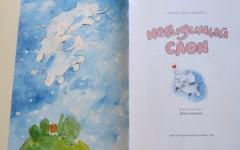Symbolism as an artistic movement arose in Russian literature in the late 19th - early 20th century. The foundations of the aesthetics of symbolism were laid by the French poets of the late 70s of the last century P. Verlaine, A. Rimbaud and others.
A poetic symbol is considered a more effective artistic tool than an image. A symbol is a certain sign that indicates the connection between the real world and the ideal. Symbolists become champions of the intuitive perception of the world through symbolic correspondences, for example, between form and color, smell and sound. The poet has a magical power that gives him the opportunity to comprehend the secrets of the world.
The peculiarity of Russian symbolism lies in the constant attention to the individual, his role in history, a connection with Eternity.
The founders of symbolism in Russian literature are V. Ya. Bryusov, K. D. Balmont, V. S. Solovyov, F. K. Sologub. Their work is characterized, first of all, by attention to history and the connection of modernity with the past. These bonds, in their opinion, determine the future. They place art above all else. It is more important to them than life.
A pale young man with burning eyes,
Now I give you three covenants. First
Accept: do not live in the present, Only
The future is the realm of the poet. remember
Second: do not sympathize with anyone, Himself
Love yourself endlessly
Keep the third: worship art,
Only to him, recklessly, aimlessly.
So Bryusov defined his poetic credo. The aesthetic views of the Symbolists were greatly influenced by the philosophy of V. Solovyov, who believed that there is a relationship in cosmic and earthly life, the unity of all manifestations of life with God. In his poems, this idea is embodied as follows:
Dear friend, can't you see
That everything we see is only
Reflection, only shadows
Invisible to the eye?
Of particular importance in the work of the Symbolists is the musicality of the poem, which they perceive as a reflection of the music of the cosmos. Here is how K. D. Balmont felt it:
Like living statues, in sparks of moonlight,
The outlines of pines, firs and birches tremble a little;
The prophetic forest calmly slumbers, the bright shine of the moon accepts
And listens to the murmuring of the breeze, all full of secret dreams.
Russian symbolism acquired its highest achievement in the work of Alexander Blok. His images-symbols lose their generality, but acquire the intimacy and concreteness of experiences. In the first collection of Poems about the Beautiful Lady, the poet creates symbolic images that will pass through all his work: his beloved, his wife, his homeland. The poet contrasts the ideal world, the world of his love, with the real one. He proves that love can lift a person above reality, make beautiful the ugly. The image of a beautiful lady is a symbol that Blok uses to reveal manifestations of beauty invisible to others in real life. In the poem "The Stranger", the Beautiful Lady is transformed into a mysterious girl who struck the imagination of the lyrical hero. Only he sees in her a mysterious ideal, others are not able to rise above reality.
And every evening, at the appointed hour (Il
Is it just me dreaming?), Maiden's camp,
Caught in silks, In the misty
Moves window.
And chained by a strange closeness,
I look at the dark veil, And I see the shore
Enchanted And enchanted distance.
There is a treasure in my soul, and
The key is entrusted only to me! You are right
Drunk monster! I know the truth is
These fragments from Blok's poetry show how the image of the Beautiful Lady is created. The composition of the poem is circular, which emphasizes that the poet himself is not able to escape from the real world.
The writer Khodasevich gave a very apt description of symbolism, who noted that the symbolists tried not to separate the personality of the poet from his work, they were looking for opportunities to combine life and work, they tried to find a genius who could subordinate his life to creativity. Therefore, the symbolists gave great importance to the cyclic composition of the work. Life is a cycle, a circle. The art cycle is an attempt to reproduce life. All symbolist poets created not just poems, but cycles of poems, and the content of each can be fully understood only in connection with other poems in the cycle. For example, Blok very carefully added each poem to the cycle, the title of which seemed to require nothing of the kind - “Different Poems”. However, the very name of the cycle and the poems become clear only in connection. This cycle combines poems from 1907 to 1916, it was a time of intense search for a new ideal by the poet, the image of the Beautiful Lady no longer satisfied him. In poems, he refers to friends ("Friends"), poets ("Poets"), historical and literary heroes ("Steps of the Commander", "To the Muse"). Thus, the name of the cycle reflects the orientation of the poet's searches.
Symbolists have played a very important role in the history of Russian literature. They opened up new themes, ideas in creativity, new possibilities of the poetic word, turned poetry into its aesthetic content.
The 19th century, which became a period of extraordinary rise in national culture and grandiose achievements in all areas of art, was replaced by a complex, full of dramatic events and turning points of the 20th century. The golden age of social and artistic life was replaced by the so-called silver one, which gave rise to the rapid development of Russian literature, poetry and prose in new bright trends, and subsequently became the starting point of its fall.
In this article, we will focus on the poetry of the Silver Age, consider it and talk about the main directions, such as symbolism, acmeism and futurism, each of which was distinguished by the special music of the verse and a vivid expression of the experiences and feelings of the lyrical hero.
Poetry of the Silver Age. A turning point in Russian culture and art
It is believed that the beginning of the Silver Age of Russian literature falls on 80-90 years. 19th century At this time, the works of many remarkable poets appeared: V. Bryusov, K. Ryleev, K. Balmont, I. Annensky - and writers: L. N. Tolstoy, F. M. Dostoevsky, M. E. Saltykov-Shchedrin. The country is going through difficult times. During the reign of Alexander I, first there is a strong patriotic upsurge during the war of 1812, and then, due to a sharp change in the previously liberal policy of the tsar, society experiences a painful loss of illusions and severe moral losses.

The poetry of the Silver Age reaches its heyday by 1915. Public life and the political situation are characterized by a deep crisis, a restless, seething atmosphere. Mass demonstrations are growing, life is being politicized and at the same time personal self-awareness is being strengthened. Society is making strenuous attempts to find a new ideal of power and social order. And poets and writers keep up with the times, mastering new art forms and offering bold ideas. The human personality begins to be realized as a unity of many principles: natural and social, biological and moral. During the years of the February, October revolutions and the Civil War, the poetry of the Silver Age is in crisis.

A. Blok's speech "On the appointment of the poet" (February 11, 1921), delivered by him at a meeting on the occasion of the 84th anniversary of the death of A. Pushkin, becomes the final chord of the Silver Age.
Characteristics of the literature of the XIX - early XX centuries.
Let's look at the features of the poetry of the Silver Age. Firstly, one of the main features of the literature of that time was a huge interest in eternal topics: the search for the meaning of the life of an individual and all of humanity as a whole, the riddles of the national character, the history of the country, the mutual influence of the worldly and spiritual, the interaction of man and nature. Literature at the end of the 19th century becomes more and more philosophical: the authors reveal the themes of war, revolution, personal tragedy of a person who, due to circumstances, has lost peace and inner harmony. In the works of writers and poets, a new, bold, extraordinary, resolute and often unpredictable hero is born, who stubbornly overcomes all hardships and hardships. In most works, close attention is paid to precisely how the subject perceives tragic social events through the prism of his consciousness. Secondly, a feature of poetry and prose was an intensive search for original artistic forms, as well as means of expressing feelings and emotions. Poetic form and rhyme played a particularly important role. Many authors abandoned the classical presentation of the text and invented new techniques, for example, V. Mayakovsky created his famous "ladder". Often, to achieve a special effect, the authors used speech and language anomalies, fragmentation, alogisms, and even allowed

Thirdly, the poets of the Silver Age of Russian poetry freely experimented with the artistic possibilities of the word. In an effort to express complex, often contradictory, "volatile" spiritual impulses, the writers began to treat the word in a new way, trying to convey the subtlest shades of meanings in their poems. Standard, formulaic definitions of clear objective objects: love, evil, family values, morality - began to be replaced by abstract psychological descriptions. Precise concepts gave way to hints and understatements. Such fluctuation, fluidity of verbal meaning was achieved through the brightest metaphors, which often began to be based not on the obvious similarity of objects or phenomena, but on non-obvious signs.

Fourthly, the poetry of the Silver Age is characterized by new ways of conveying thoughts and feelings of the lyrical hero. The poems of many authors began to be created using images, motifs from different cultures, as well as hidden and explicit quotations. For example, many word artists included scenes from Greek, Roman and a little later Slavic myths and traditions in their creations. In the works of M. Tsvetaeva and V. Bryusov, mythology is used to build universal psychological models that make it possible to comprehend the human personality, in particular its spiritual component. Each poet of the Silver Age is brightly individual. It is easy to understand which of them belongs to certain verses. But they all tried to make their works more tangible, alive, full of colors, so that any reader could feel every word and line.
The main directions of the poetry of the Silver Age. Symbolism
Writers and poets who opposed realism announced the creation of a new, contemporary art - modernism. There are three main poetry of the Silver Age: symbolism, acmeism, futurism. Each of them had its own striking features. Symbolism originally arose in France as a protest against the everyday display of reality and dissatisfaction with bourgeois life. The founders of this trend, including J. Morsas, believed that only with the help of a special hint - a symbol, one can comprehend the secrets of the universe. Symbolism appeared in Russia in the early 1890s. The founder of this trend was D. S. Merezhkovsky, who proclaimed in his book three main postulates of the new art: symbolization, mystical content and "expansion of artistic impressionability."

Senior and junior symbolists
The first symbolists, later named senior, were V. Ya. Bryusov, K. D. Balmont, F. K. Sologub, Z. N. Gippius, N. M. Minsky, and other poets. Their work was often characterized by a sharp denial of the surrounding reality. They portrayed real life as boring, ugly and meaningless, trying to convey the subtlest shades of their sensations.

Period from 1901 to 1904 marks the onset of a new milestone in Russian poetry. The poems of the Symbolists are imbued with a revolutionary spirit and a premonition of future changes. The younger symbolists: A. Blok, V. Ivanov, A. Bely - do not deny the world, but utopianly await its transformation, praising divine beauty, love and femininity, which will surely change reality. It is with the appearance of the younger symbolists on the literary arena that the concept of a symbol enters literature. Poets understand it as a multifaceted word that reflects the world of "heaven", the spiritual essence and at the same time the "earthly kingdom".
Symbolism during the Revolution
Poetry of the Russian Silver Age in 1905-1907. is undergoing changes. Most Symbolists, focusing on the socio-political events taking place in the country, are reconsidering their views on the world and beauty. The latter is now understood as the chaos of struggle. Poets create images of a new world that comes to replace the dying one. V. Ya. Bryusov creates the poem "The Coming Huns", A. Blok - "The Barge of Life", "Rising from the darkness of the cellars ...", etc.

The symbolism also changes. Now she turns not to the ancient heritage, but to Russian folklore, as well as Slavic mythology. After the revolution, there is a demarcation of the symbolists, who want to protect art from the revolutionary elements and, on the contrary, are actively interested in the social struggle. After 1907, the disputes of the Symbolists exhausted themselves, and imitation of the art of the past replaced it. And since 1910, Russian symbolism has been in crisis, clearly reflecting its internal inconsistency.
Acmeism in Russian poetry
In 1911, N. S. Gumilyov organized a literary group - the Workshop of Poets. It included the poets O. Mandelstam, G. Ivanov and G. Adamovich. This new direction did not reject the surrounding reality, but accepted reality as it is, asserting its value. The "Workshop of Poets" began to publish its own magazine "Hyperborea", as well as print works in "Apollo". Acmeism, originating as a literary school to find a way out of the crisis of symbolism, brought together poets very different in ideological and artistic settings.

Features of Russian futurism
The Silver Age in Russian poetry gave rise to another interesting trend called "futurism" (from Latin futurum, that is, "future"). The search for new artistic forms in the works of the brothers N. and D. Burlyukov, N. S. Goncharova, N. Kulbina, M. V. Matyushin became a prerequisite for the emergence of this trend in Russia.

In 1910, the futuristic collection "The Garden of Judges" was published, in which the works of such brightest poets as V. V. Kamensky, V. V. Khlebnikov, the Burliuk brothers, E. Guro were collected. These authors formed the core of the so-called Cubo-Futurists. Later, V. Mayakovsky joined them. In December 1912, an almanac was published - "A Slap in the Face of Public Taste". The verses of the Cubo-Futurists "Buch of the Forest", "Dead Moon", "Roaring Parnassus", "Gag" became the subject of numerous disputes. At first, they were perceived as a way to tease the habits of the reader, but a closer reading revealed a keen desire to show a new vision of the world and a special social involvement. Anti-aestheticism turned into a rejection of soulless, fake beauty, rudeness of expressions was transformed into the voice of the crowd.

egofuturists
In addition to cubofuturism, several other currents arose, including egofuturism, headed by I. Severyanin. He was joined by such poets as V. I. Gnezdov, I. V. Ignatiev, K. Olimpov and others. They created the publishing house "Petersburg Herald", published magazines and almanacs with original names: "Skycops", "Eagles over the abyss", "Zasakhare Kry", etc. Their poems were distinguished by extravagance and were often composed of words they themselves created. In addition to the ego-futurists, there were two more groups: Centrifuge (B. L. Pasternak, N. N. Aseev, S. P. Bobrov) and Mezzanine of Poetry (R. Ivnev, S. M. Tretyakov, V. G. Sherenevich).

Instead of a conclusion
The Silver Age of Russian poetry was short-lived, but united a galaxy of the brightest, most talented poets. Many of their biographies developed tragically, because by the will of fate they had to live and work in such a fatal time for the country, a turning point in the revolutions and chaos of the post-revolutionary years, the civil war, the collapse of hopes and rebirth. Many poets died after the tragic events (V. Khlebnikov, A. Blok), many emigrated (K. Balmont, Z. Gippius, I. Severyanin, M. Tsvetaeva), some took their own lives, were shot or disappeared in Stalin's camps. But all of them managed to make a huge contribution to Russian culture and enrich it with their expressive, colorful, original works.
The Silver Age of Russian poetry is the designation of Russian poetry of the late 19th - early 20th centuries. It was given by analogy with the golden age.
There is an extensive literature about Russian poetry of the Silver Age - both domestic and foreign researchers wrote a lot about it, including such prominent scientists as V.M. Zhirmunsky, V. Orlov, L.K. Dolgopolov, continue to write to M.L. Gasparov, R.D. Timenchik, N.A. Bogomolov and many others. Numerous memoirs have been published about this era - for example, V. Mayakovsky “On the Parnassus of the Silver Age”, and Odoevtseva “On the Banks of the Neva”.
Russian poetry of the Silver Age was created in the atmosphere of a general cultural upsurge as a significant part of it. It is characteristic that at the same time such brightest talents as A. Blok and V. Mayakovsky, A. Bely and V. Khodasevich could create in one and the same country. This list goes on and on. In the history of world literature, this phenomenon was unique.
Late 19th - early 20th century in Russia, this is a time of change, uncertainty and gloomy omens, this is a time of disappointment and a sense of the approaching death of the existing socio-political order. All this could not but affect Russian poetry. It is with this that the emergence of symbolism is connected.
Symbolism was a heterogeneous phenomenon, uniting in its ranks poets who held the most contradictory views. Some of the Symbolists, such as N.Minsky, D.Merezhkovsky, began their career as representatives of civil poetry, and then began to focus on the ideas of "god-building" and "religious community".
Real life is portrayed as ugly, evil, boring and meaningless. Symbolists paid special attention to artistic innovation - the transformation of the meanings of the poetic word, the development of rhythm, rhyme, etc. the "senior symbolists" do not yet create a system of symbols; They are impressionists who strive to convey the subtlest shades of moods and impressions. The word as such lost its value for the symbolists.
It became valuable only as a sound, a musical note, as a link in the overall melodic construction of a poem.
A new period in the history of Russian symbolism (1901 - 1904) coincided with the beginning of a new revolutionary upsurge in Russia. Pessimistic moods inspired by the era of reaction in the 1880s - early 1890s. and the philosophy of A. Schopenhauer, give way to premonitions of "unheard of changes." “Junior symbolists” enter the literary arena - followers of the idealist philosopher and poet V. Solovyov, who imagined that the old world was on the verge of complete destruction, that divine Beauty (Eternal Femininity, the Soul of the World) enters the world, which should “save the world”, connecting the heavenly (divine) beginning of life with the earthly, material, create the “kingdom of God on earth”:
Know this: Eternal Femininity is now
He comes to earth in an incorruptible body.
In the light of the unfading new goddess
The sky merged with the abyss of water.
The years of the first Russian revolution (1905-1907) again significantly change the face of Russian symbolism. Most poets respond to revolutionary events. Blok creates images of the people of the new, popular world. V.Ya. Bryusov writes the famous poem "The Coming Huns", where he glorifies the inevitable end of the old world, to which, however, he counts himself and all the people of the old, dying culture. During the years of the revolution, F.K. Sologub creates a book of poems "Motherland" (1906), K.D. Balmont - a collection of "Songs of the Avenger" (1907), published in Paris and banned in Russia, etc.
More importantly, the years of the revolution rebuilt the symbolic artistic worldview. If earlier Beauty was understood as harmony, now it is associated with the chaos of struggle, with the elements of the people.
Individualism is replaced by the search for a new personality, in which the flowering of the “I” is connected with the life of the people. The symbolism is also changing: previously associated mainly with the Christian, ancient, medieval and romantic tradition, now it turns to the heritage of the ancient “national” myth (V.I. Ivanov), to Russian folklore and Slavic mythology (A. Blok, M. M. Gorodetsky) The mood of the symbol also becomes different. An increasingly important role in it is played by its earthly meanings: social, political, historical.
By the end of the first decade of the 20th century, symbolism, as a school, was in decline. Separate works of symbolist poets appear, but his influence, as a school, has been lost. Everything young, viable, vigorous is already outside of him.
Symbolism no longer gives new names.
Symbolism has outlived itself, and this outliving has gone in two directions. On the one hand, the demand for obligatory "mysticism", "disclosure of secrets", "comprehension" of the infinite eventually led to the loss of the authenticity of poetry; The “religious and mystical pathos” of the luminaries of symbolism turned out to be replaced by a kind of mystical stencil, template. On the other hand, the passion for the “musical basis” of the verse led to the creation of poetry, devoid of any logical meaning, in which the word is reduced to the role of not a musical sound, but a tin, ringing trinket.
Accordingly, the reaction against symbolism, and subsequently the struggle against it, followed the same two main lines.
On the one hand, the acmeists opposed the ideology of symbolism. On the other hand, the Futurists, who were also ideologically hostile to symbolism, came out in defense of the word as such.
Early twentieth century. How much this period of history has brought for the Russian people. This is also a large-scale technical breakthrough: for the first time, telephones, light bulbs, and cars are being used. These are bloody wars and revolutions.
This is a bright, unshakable faith in the best that helped people with dignity and honor to go through all the trials. If to characterize this period in one word, then the word “Breakthrough” will be the most appropriate. Society was able to say goodbye to its past and opened up to innovations, absorbing new ideas. Literature, like a mirror, reflected all the changes that took place in the life of the nation.
New techniques in the literary process of the first half of the twentieth century
The literary process in the first half of the twentieth century acquires new styles, new techniques, it combines modernism and realism. For literary works, fantastic absurdity becomes characteristic, as a new experimental form. If in the 19th century literary works described clear objective objects, for example, love, evil, family and social relations, then in the updated literature of the 20th century, abstract psychological techniques are used primarily to describe this or that thing.
Literature is filled with a special philosophy. The main themes that were used in creativity are war, revolution, problems of religious perception, and most importantly, the tragedy of a person, a person who, due to circumstances, has lost his inner harmony. Lyrical characters become more daring, resolute, extraordinary, unpredictable.
Many writers also refuse the classical stylistic presentation of the text - the famous "ladder" of V. Mayakovsky appears. The experience of the literary masters of the past is not rejected, but is complemented by bolder modern elements. For example, Yesenin's versification style is very close to Pushkin's, but they cannot be compared and identified. In most works, interest in the subject, in how a person perceives social events through the prism of his consciousness, is brought to the fore.
At the beginning of the 20th century, mass literature appeared. Works that were not of high artistic value, but were widely distributed among the population.
The influence of public and state life on literature
During this period, writers and poets were in anticipation of new changes and explosions in public and state life. This, of course, greatly influenced their work. Someone in their works inspired people and instilled faith in a new beautiful future, someone with pessimism and anguish convinced of the inevitability of grief and suffering.
The authoritarian intervention of the new government played a significant role in the development of the literary process. Some writers chose the dissident path for themselves, some began to build the country of socialism in their works, glorify the working class and the communist party.
Despite the fact that many literary figures were forced to leave the country due to political motives, Russian literature does not die in emigration. The most famous Russian literary figures in exile include Bunin, Tsvetaeva, Kuprin, Khodasevich, Shmelev.
Russian literature of the beginning of the 20th century was characterized by an awareness of the crisis of old ideas about values, and a large-scale reassessment of them is taking place. New literary trends and schools are emerging. There is a revival of renewed poetry, which marks the beginning of the Silver Age of Russian literature.
The Silver Age is not a chronological period. At least not only the period. And this is not the sum of literary movements. Rather, the concept of "Silver Age" is appropriate to apply to the way of thinking.
Atmosphere of the Silver Age
At the end of the nineteenth and beginning of the twentieth century, Russia experienced an intense intellectual upsurge, which was especially pronounced in philosophy and poetry. Philosopher Nikolai Berdyaev (read about him) called this time the Russian cultural renaissance. According to Berdyaev's contemporary Sergei Makovsky, it is Berdyaev who also owns another, more well-known definition of this period - the "Silver Age". According to other sources, the phrase "Silver Age" was first used in 1929 by the poet Nikolai Otsup. This concept is not so much scientific as emotional, immediately evoking associations with another short period in the history of Russian culture - with the "golden age", the Pushkin era of Russian poetry (the first third of the 19th century).
“Now it is difficult to imagine the atmosphere of that time,” Nikolai Berdyaev wrote about the Silver Age in his “philosophical autobiography” “Self-Knowledge”. - Much of the creative upsurge of that time was included in the further development of Russian culture and now is the property of all Russian cultured people. But then there was an intoxication with a creative upsurge, novelty, tension, struggle, challenge. During these years, many gifts were sent to Russia. This was the era of the awakening of independent philosophical thought in Russia, the flowering of poetry and the sharpening of aesthetic sensibility, religious anxiety and quest, interest in mysticism and the occult. New souls appeared, new sources of creative life were discovered, new dawns were seen, the feeling of decline and death was combined with the hope of the transformation of life. But everything happened in a rather vicious circle ... "
The Silver Age as a period and way of thinking
The art and philosophy of the Silver Age were distinguished by elitism and intellectualism. Therefore, it is impossible to identify all the poetry of the late XIX - early XX century with the Silver Age. This is a narrower concept. Sometimes, however, when attempting to determine the essence of the ideological content of the Silver Age through formal features (literary movements and groupings, socio-political subtexts and contexts), researchers mistakenly confuse them. In fact, within the chronological boundaries of this period, the most diverse phenomena in origin and aesthetic orientation coexisted: modernist movements, poetry of the classical realistic tradition, peasant, proletarian, satirical poetry ... But the Silver Age is not a chronological period. At least not only the period. And this is not the sum of literary movements. Rather, the concept of the “Silver Age” is appropriate to apply to the way of thinking, which, being characteristic of artists who were at enmity with each other during their lifetime, ultimately merged them in the minds of their descendants into a kind of inseparable galaxy that formed that specific atmosphere of the Silver Age, about which Berdyaev wrote.
Poets of the Silver Age
The names of the poets who made up the spiritual core of the Silver Age are known to everyone: Valery Bryusov, Fedor Sologub, Innokenty Annensky, Alexander Blok, Maximilian Voloshin, Andrei Bely, Konstantin Balmont, Nikolai Gumilyov, Vyacheslav Ivanov, Igor Severyanin, Georgy Ivanov and many others.
In its most concentrated form, the atmosphere of the Silver Age was expressed in the first decade and a half of the twentieth century. It was the heyday of Russian modern literature in all its diversity of artistic, philosophical, religious searches and discoveries. The First World War, the February bourgeois-democratic and October socialist revolutions partly provoked, partly shaped this cultural context, and partly were provoked and shaped by it. Representatives of the Silver Age (and Russian modernism in general) sought to overcome positivism, reject the legacy of the "sixties", denied materialism, as well as idealistic philosophy.
The poets of the Silver Age also sought to overcome the attempts of the second half of the 19th century to explain human behavior by social conditions, the environment, and continued the traditions of Russian poetry, for which a person was important in itself, his thoughts and feelings, his attitude to eternity, to God, to Love and Death in a philosophical, metaphysical sense. The poets of the Silver Age, both in their artistic work and in theoretical articles and statements, questioned the idea of progress for literature. For example, one of the brightest creators of the Silver Age, Osip Mandelstam, wrote that the idea of progress is "the most disgusting kind of school ignorance." And Alexander Blok in 1910 stated: “The sun of naive realism has set; it is impossible to comprehend anything outside of symbolism. Poets of the Silver Age believed in art, in the power of the word. Therefore, for their creativity, immersion in the element of the word, the search for new means of expression is indicative. They cared not only about the meaning, but also about the style - the sound, the music of the word and complete immersion in the elements were important for them. This immersion led to the cult of life creation (the inseparability of the creator's personality and his art). And almost always in connection with this, the poets of the Silver Age were unhappy in their personal lives, and many of them ended badly.








